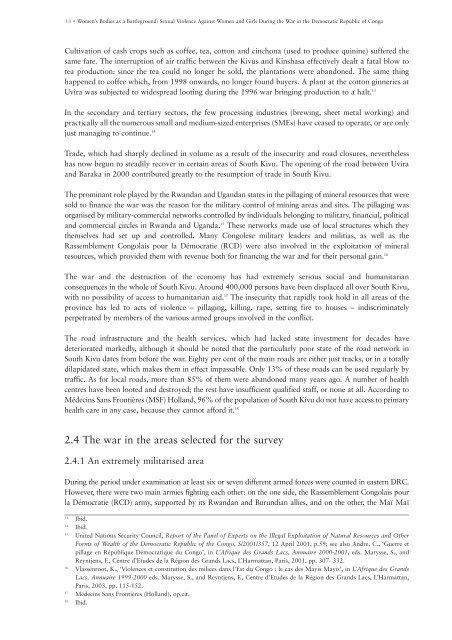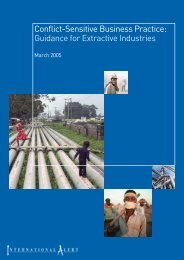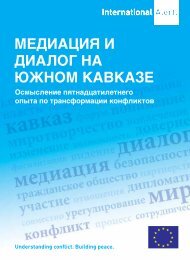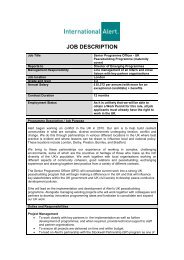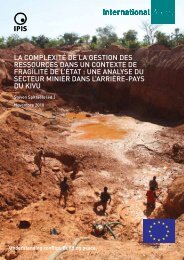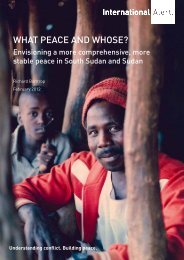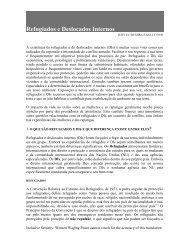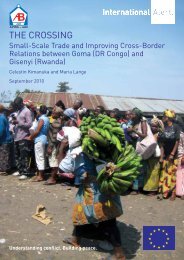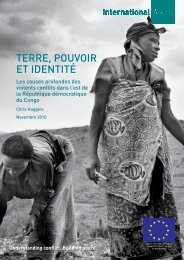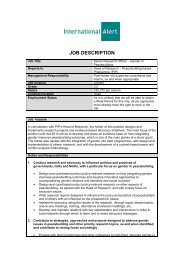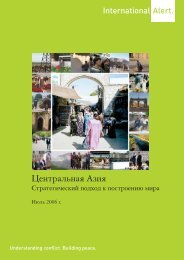18 • Women’s Bodies as a Battleground: Sexual Violence Against Women and Girls During the War in the Democratic Republic of CongoCultivation of cash crops such as coffee, tea, cotton and cinchona (used to produce quinine) suffered thesame fate. The interruption of air traffic between the Kivus and Kinshasa effectively dealt a fatal blow totea production: since the tea could no longer be sold, the plantations were abandoned. The same thinghappened to coffee which, from 1998 onwards, no longer found buyers. A plant at the cotton ginneries atUvira was subjected to widespread looting during the 1996 war bringing production to a halt. 13In the secondary and tertiary sectors, the few processing industries (brewing, sheet metal working) andpractically all the numerous small and medium-sized enterprises (SMEs) have ceased to operate, or are onlyjust managing to continue. 14Trade, which had sharply declined in volume as a result of the insecurity and road closures, neverthelesshas now begun to steadily recover in certain areas of South Kivu. The opening of the road between Uviraand Baraka in 2000 contributed greatly to the resumption of trade in South Kivu.The prominant role played by the Rwandan and Ugandan states in the pillaging of mineral resources that weresold to finance the war was the reason for the military control of mining areas and sites. The pillaging wasorganised by military-commercial networks controlled by individuals belonging to military, financial, politicaland commercial circles in Rwanda and Uganda. 15 These networks made use of local structures which theythemselves had set up and controlled. Many Congolese military leaders and militias, as well as theRassemblement Congolais pour la Démocratie (RCD) were also involved in the exploitation of mineralresources, which provided them with revenue both for financing the war and for their personal gain. 16The war and the destruction of the economy has had extremely serious social and humanitarianconsequences in the whole of South Kivu. Around 400,000 persons have been displaced all over South Kivu,with no possibility of access to humanitarian aid. 17 The insecurity that rapidly took hold in all areas of theprovince has led to acts of violence – pillaging, killing, rape, setting fire to houses – indiscriminatelyperpetrated by members of the various armed groups involved in the conflict.The road infrastructure and the health services, which had lacked state investment for decades havedeteriorated markedly, although it should be noted that the particularly poor state of the road network inSouth Kivu dates from before the war. Eighty per cent of the main roads are either just tracks, or in a totallydilapidated state, which makes them in effect impassable. Only 13% of these roads can be used regularly bytraffic. As for local roads, more than 85% of them were abandoned many years ago. A number of healthcentres have been looted and destroyed; the rest have insufficient qualified staff, or none at all. According toMédecins Sans Frontières (MSF) Holland, 96% of the population of South Kivu do not have access to primaryhealth care in any case, because they cannot afford it. 182.4 The war in the areas selected for the survey2.4.1 An extremely militarised areaDuring the period under examination at least six or seven different armed forces were counted in eastern DRC.However, there were two main armies fighting each other: on the one side, the Rassemblement Congolais pourla Démocratie (RCD) army, supported by its Rwandan and Burundian allies, and on the other, the Maï Maï13.Ibid.14.Ibid.15.United Nations Security Council, Report of the Panel of Experts on the Illegal Exploitation of Natural Resources and OtherForms of Wealth of the Democratic Republic of the Congo, S/2001/357, 12 April 2001, p.59; see also Andre, C., ‘Guerre etpillage en République Démocratique du Congo’, in L’Afrique des Grands Lacs, Annuaire 2000-2001, eds. Marysse, S., andReyntjens, F., Centre d’Etudes de la Région des Grands Lacs, L’Harmattan, Paris, 2001, pp. 307- 332.16.Vlassenroot, K., ‘Violences et constitution des milices dans l’Est du Congo : le cas des Mayis Mayis’, in L’Afrique des GrandsLacs, Annuaire 1999-2000 eds. Marysse, S., and Reyntjens, F., Centre d’Etudes de la Région des Grands Lacs, L’Harmattan,Paris, 2003, pp. 115-152.17.Médecins Sans Frontières (Holland), op.cit.18.Ibid.
19 • Women’s Bodies as a Battleground: Sexual Violence Against Women and Girls During the War in the Democratic Republic of Congomilitias, allied with the Rwandan and Burundian Hutu rebels. But the situation was made more complex by thevolatile nature of the alliances between the various armed factions active on the ground; constantly changingaccording to the political context of the moment and to their own respective interests. In addition to this militaryaction there was predatory economic activity, especially in mining and trade. All this helped to create an explosivesituation in which the civilian populations were, effectively, taken hostage and there were massive violations ofhuman rights, especially those of women. The main forces present on the ground were the following:2.4.1.1 The army of the Rassemblement Congolais pour la Démocratie (RCD-Goma)The RCD-Goma had its own army, l’Armée Nationale Congolaise (ANC), which was the main armedopposition to the regime in Kinshasa. This heterogeneous army was made up of soldiers from the remnantsof Mobutu’s army, ‘Kadogos’ 19 of the Alliance des Forces Démocratiques pour la Libération du Congo-Zaïre(AFDL), who had taken part in the capture of Kinshasa in 1996, elements from Kasaï, recruited under thepatronage of Dr Adolphe Onusumba Yemba, former president of the RCD, Banyamulenge militias, who hadfought in the ranks of the Rwandan Patriotic Front (RPF) in 1990, Congolese Hutus recruited in Rutshuru,and other Banyamulenge militias. 20 The RCD army numbered between 20,000 and 30,000 men. 21The RCD exercised political, administrative and military control in eastern DRC from 1998 to 2003, thanksto the active support of Rwanda. It justifies its existence by the need to protect the Congolese Tutsipopulation. It has long had very close links with the Banyamulenge community of South Kivu. However,disagreements between the rebel movement and part of that community triggered bloody fighting in theMinembwe region on the Haut Plateaux from February 2002 onwards.The RCD joined the transitional government of national unity which was set up in Kinshasa in June 2003,following the signing of the Pretoria Accords. 22 Having been originally a politico-military movement, theRCD transformed itself into a political party, whilst its army was to be integrated in the new national army.However, this integration has still not taken place, since the transitional government continues to beundermined and torn apart by internal power struggles and also is paralysed by mutual suspicion among itsdifferent components. The former RCD factions, and other armed groups that are part of the newgovernment in fact retain their own military structures, under the aegis of the restructured national army. 23Moreover, despite the official reunification of the country in June 2003, the transitional government has metwith enormous difficulties in exercising its political, military and administrative authority throughout thecountry, especially in the provinces of South and North Kivu, where the RCD remains very influential.2.4.1.2 The Rwandan Patriotic Army (RPA) 24Until its official withdrawal from the east of the DRC in September–October 2002, the Rwandan armyretained a strong presence there. It was obliged to withdraw its troops under pressure from theinternational community, notably the United States of America, but Rwanda nevertheless reorganised itself,restructuring the military arm of the RCD-Goma and creating a rapid intervention force which could beredeployed in eastern Congo if necessary. 25Before their withdrawal, it was estimated that the Rwandan troops numbered between 25,000 and 35,000.Rwanda cites security considerations as the justification for its presence in the DRC; i.e. the need to protectits borders from Rwandan Hutu rebels operating in North and South Kivus under the banner of the ForcesDémocratiques de Libération du Rwanda (FDLR), numbering between 15,000 and 20,000 men. 2619.Child soldiers aged 10–15, recruited to fight in the ranks of the AFDL.20.<strong>International</strong> Crisis Group, The Kivus: The forgotten crucible of the Congo conflict, Africa Report No 56, Nairobi/Brussels, 24January 2003, p.10.21.Ibid.22.The Pretoria Accords on a transitional government of national union were signed in December 2002. According to the terms ofthese accords, Joseph Kabila was to remain President of the Republic for a period of two years, to be followed by free elections.The agreement also provides for the nomination of four vice-presidents from rebel movements (MLC, RCD-Goma), the armedopposition and civil society, and for a government comprising 36 ministers and 25 vice/deputy ministers.23.<strong>International</strong> Crisis Group, S’éloigner du gouffre au Congo, Africa Report No 18, Kinshasa/ Nairobi/Brussels, 7 July 2004, p.3.24.The RPA was renamed Forces de Défense Rwandaise in July 2002.25.<strong>International</strong> Crisis Group, The Kivus: the forgotten crucible, op. cit., p.i.26.Ibid., p.3.


